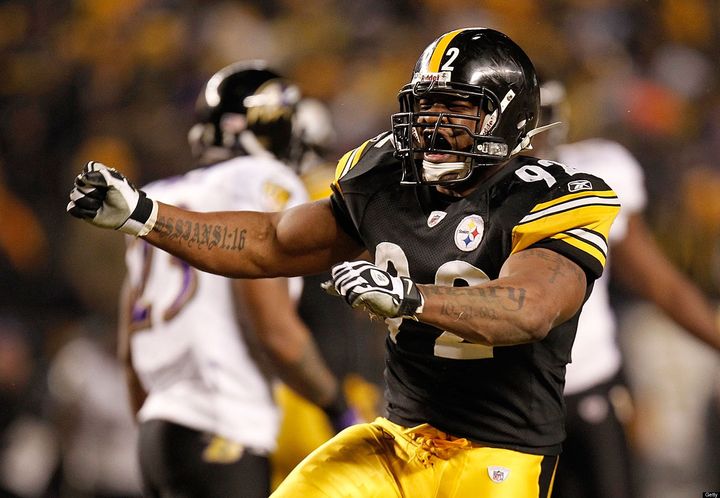
You can tell a lot about a person by the way he or she dresses for a football game. The cheesehead? There's a guy who likes to have fun. The face painter? That's an independent spirit who goes his or her own way. My favorite fan is the one holding the cardboard "D" and a matching picket fence cut-out. Talk about being clever and insightful.
With Pittsburgh and Green Bay set to square off in the Super Bowl, I thought it would be interesting to take a look at "defense" as a strategy. From Joe Greene to Troy Polamalu, Ray Nitschke to Clay Matthews, the Steelers and Packers have demonstrated how valuable an innovative defense can be on the gridiron. What about in the marketplace? Evidence suggests defense is as important to corporations as it is to sports teams. But not every organization or business appreciates how to leverage defense effectively. Take the industry for which Pittsburgh is famous: steel.
Recently I had an opportunity to talk steel with best-selling author and Harvard Business School Professor Clayton Christensen. Christensen has written about the steel industry in The Innovator's Dilemma and other publications, and he loves to discuss the lessons that can be gleaned from it.
In the steel business, he notes, two types of operators dominated the last 40 years: fully integrated, high-quality producers, and lower-cost "mini-mills." When the latter first opened in the late 1960s, they found a niche in scrap metal. Melting it did not produce high-quality sheet steel -- the kind that is used in automobiles, appliances and other products--but it did produce an acceptable, low-priced rebar.
For those unfamiliar with rebar, it is a cheap steel rod used to strengthen concrete. In the steel world, rebar occupies the lowest position on the value hierarchy. Because it produced very little profit for big mill operators, they were only too happy to cede the market to mini-mill upstarts in the 1970s. To them, it didn't make sense to expend effort to defend a low-margin business when that same energy could be applied to play offense in a higher-margin market segment.
Initially, everyone benefited from this thinking. There was peace in the industry, remembers Christensen, and greater profitability for all. At least there was until the last, integrated mill quit making rebar. When it did, prices tumbled. Without a more expensive rival to exploit, mini-mills found themselves competing against each other on price.
Desperate to make a profit, these smaller operators turned their eyes up-market. After some trial and error, they soon figured out how to make angle iron for significantly less than bigger operators. As they did before, the fully integrated mills ceded territory to focus on structural steel that produced larger margins than angle iron and rebar.
Like a football team clinging to a late lead, the large steel mills chose to play what is called "prevent defense" -- a tactic that attempts to slow but often fails to stop a hard-charging opponent. For a while, the ploy worked in steel. But then the inevitable happened whenever the mini-mills encroached: as soon as the low-cost operators produced a quality product, the large mills began to give up market share in chunks at a time. It happened in structural steel and then again in sheet metal. Eventually, the fully integrated mills ran out of markets in which they could go on the offensive. Having never developed a true defensive strategy, most wound up shuttering their operations.
The story of the steel industry is hardly an isolated lesson. When Ford and GM found themselves under attack by Toyota and Honda in the 1970s and 1980s, they put up only a modest defense in compact cars and sedans. Instead, they focused on playing offense in high-profit trucks and SUVs. For a while, the strategy worked. But as we all know now, Toyota and Honda soon overtook the American producers in small cars and passenger sedans. And then they went on the offensive and challenged Detroit's Big Three head-on in SUVs and trucks.
Ironically, Toyota and Honda now find themselves struggling after moving up market. The skills and tactics that served them well in their offensive assault of GM, Ford and Chrysler don't seem to be working as effectively now that they are on defense against Hyundai and Kia.
The lesson for business practitioners is simple: in order to prevail, you need a good offense in the way of disruptive innovation or aggressive pricing. But you also need a solid defense that can protect your gains and preserve you advantages. This could mean developing best practices to ensure the consistent delivery of service, or making systematic improvements to increase efficiencies. While defensive skills don't come as naturally to entrepreneurs who tend to be more offensive-minded, they are just as important to their long-term success.
When you sit to watch the game this weekend, enjoy the spectacle of the cheesehead and the "terrible towel" waver, but remember this: the guy with the "D" and the fence may not be as entertaining, but he knows what it takes to win.
Inder Sidhu is the Senior Vice President of Strategy & Planning for Worldwide Operations at Cisco, and the author of Doing Both: How Cisco Captures Today's Profits and Drives Tomorrow's Growth. Author proceeds from sales of Doing Both go to charity. Follow Inder on Twitter at @indersidhu.